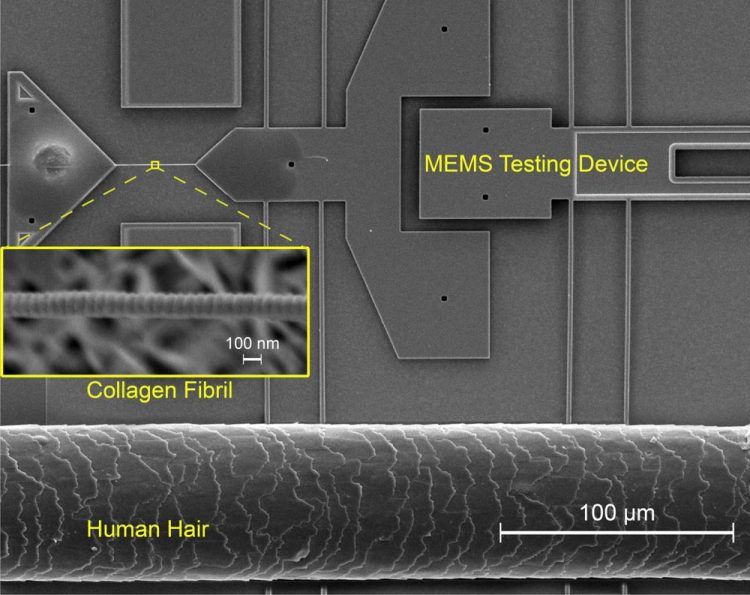Collagen nanofibrils in mammalian tissues get stronger with exercise

A collagen fibril mounted on a MEMS mechanical testing device. At the bottom is a single human hair for size comparison. Credit: University of Illinois Department of Aerospace Engineering
Because one collagen fibril is about one millionth in size of the cross-section of a human hair, studying it requires equally small equipment. The group in the Department of Aerospace Engineering at U of I designed tiny devices–Micro-Electro-Mechanical Systems–smaller than one millimeter in size, to test the collagen fibrils.
“Using MEMS-type devices to grip the collagen fibrils under a high magnification optical microscope, we stretched individual fibrils to learn how they deform and the point at which they break,” said Debashish Das, a postdoctoral scholar at Illinois who worked on the project. “We also repeatedly stretched and released the fibrils to measure their elastic and inelastic properties and how they respond to repeated loading.”
Das explained, “Unlike a rubber band, if you stretch human or animal tissue and then release it, the tissue doesn't spring back to its original shape immediately. Some of the energy expended in pulling it is dissipated and lost. Our tissues are good at dissipating energy-when pulled and pushed, they dissipate a lot of energy without failing.
This behavior has been known and understood at the tissue-level and attributed to either nanofibrillar sliding or to the gel-like hydrophilic substance between collagen fibrils. The individual collagen fibrils were not considered as major contributors to the overall viscoelastic behavior. But now we have shown that dissipative tissue mechanisms are active even at the scale of a single collagen fibril.”
A very interesting and unexpected finding of the study is that collagen fibrils can become stronger and tougher when they are repeatedly stretched and let to relax.
“If we repeatedly stretch and relax a common engineering structure, it is more likely to become weaker due to fatigue,” said U of I Professor Ioannis Chasiotis. “While our body tissues don't experience anywhere near the amount of stress we applied to individual collagen fibrils in our lab experiments, we found that after crossing a threshold strain in our cyclic loading experiments, there was a clear increase in fibril strength, by as much as 70 percent.”
Das said the collagen fibrils themselves contribute significantly to the energy dissipation and toughness observed in tissues.
“What we found is that individual collagen fibrils are highly dissipative biopolymer structures. From this study, we now know that our body dissipates energy at all levels, down to the smallest building blocks. And properties such as strength and toughness are not static, they can increase as the collagen fibrils are exercised,” Das said.
What's the next step? Das said with this new understanding of the properties of single collagen fibrils, scientists may be able to design better dissipative synthetic biopolymer networks for wound healing and tissue growth, for example, which would be both biocompatible and biodegradable.
###
The study “Energy dissipation in mammalian collagen fibrils: Cyclic strain-induced damping, toughening, and strengthening,” was co-authored by Julia Liu, Debashish Das, Fan Yang, Andrea G. Schwartz, Guy M. Genin, Stavros Thomopoulos, and Ioannis Chasiotis. It is published in Acta Biomaterialia.
The research was supported by the National Science Foundation and National Institutes of Health and by the National Science Foundation Science and Technology Center for Engineering MechanoBiology. Das' effort was supported by a grant from the National Science Foundation.
Media Contact
All latest news from the category: Health and Medicine
This subject area encompasses research and studies in the field of human medicine.
Among the wide-ranging list of topics covered here are anesthesiology, anatomy, surgery, human genetics, hygiene and environmental medicine, internal medicine, neurology, pharmacology, physiology, urology and dental medicine.
Newest articles

Superradiant atoms could push the boundaries of how precisely time can be measured
Superradiant atoms can help us measure time more precisely than ever. In a new study, researchers from the University of Copenhagen present a new method for measuring the time interval,…

Ion thermoelectric conversion devices for near room temperature
The electrode sheet of the thermoelectric device consists of ionic hydrogel, which is sandwiched between the electrodes to form, and the Prussian blue on the electrode undergoes a redox reaction…

Zap Energy achieves 37-million-degree temperatures in a compact device
New publication reports record electron temperatures for a small-scale, sheared-flow-stabilized Z-pinch fusion device. In the nine decades since humans first produced fusion reactions, only a few fusion technologies have demonstrated…





















